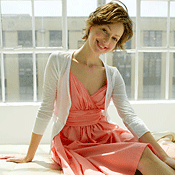Dress Your Way To Better Sex
Green reassures and red radiates. What does your color say about you?

Pink
Conventional wisdom: The color of Victorian men’s waistcoats and lace handkerchiefs, pink resonates with romantics. Later written-off as girlie, this delicate color has made a comeback, thanks in part to the aggressive marketing of pastel button-downs by Banana Republic and J. Crew.
Science says: Pink represents femininity, and it is physically soothing. According to a 2005 study on color preferences by Pantone and BuzzBack Market Research, peony pink was labeled “feminine” by 33 percent of the nearly 2,800 respondents, while 14 percent called the slightly deeper blush “cozy” and “nurturing.”
The bottom line: Pink is the ideal first-date color, since it helps a woman appear good-natured and approachable. But beware of the downside: overdosing on baby pinks relays the message “I’m young and innocent and fragile,” says Barbara Jacobs, an accredited color consultant and the founder of architectural color consulting firm Barbara Jacobs Color and Design. Avoid the naïve and sinless shtick by opting for darker hues.
Not your color? Peach and coral also give off the aura of a tender femme fatale.
Red
Conventional wisdom: A red cocktail dress is daring choice that turns heads, while red lipstick conquers the world (or at least the lounge).
Science says: Athletes wearing red often win over their physical equals in blue, according to a 2005 study by British anthropologists Russell Hill and Robert Barton of the University of Durham. The pair analyzed results from the 2004 Summer Olympics, where the staff randomly assigned competitors red or blue uniforms. In close matches, the wrestlers or boxers clad in red prevailed.
The bottom line: Trying to attract attention in a new city? Slip into a flame-colored skirt or fitted red shirt and radiate self-assurance and energy. The vibrant color will win you glances as you walk into a room, which will further boost your confidence. Many men associate red with the prototypical sexy vixen, focusing on the color like a bull focuses on the matador’s cape.
Not your color? Try darker hues, like burgundy, or keep the color away from your face by wearing a scoop-neck shirt or strapless gown. If you find the color too aggressive for clothing, opt for a pair of red heels.
Yellow
Conventional wisdom: Carefree, optimistic yellow abounds in the hot, humid tropics, from juicy pineapples and banana bunches to sprays of bold yellow flowers on mimosa trees.
Science says: The human visual system is built to process yellow the best, according to Margaret Miele, assistant professor of color psychology at Fashion Institute of Technology. Yellow pops in our vision—just ask the logo designers for Sprint and Subway.
The bottom line: You and your man have been glued to the sofa since picking up the recent season of Entourage on DVD, and you’re feeling the need to motivate. So put on a bright jacket and get going: Yellow suggests movement, according to Margaret Walch, director of consulting company Color Association and author of Living Colors: The Definite Guide to Color Palettes Through the Ages. But yellow can also foster anxiety, especially when paired with black to evoke danger-zone caution tape.
Not your color? Try on a warm gold or pale lemon shade. Orange is also motivating.
Green
Conventional wisdom: Favored by tree-huggers and environmentally friendly marketing campaigns, green represents nature.
Science says: Green reassures us. When the landscape grows lush with leaves and grass, we know both food and water are nearby, says Angela Wright, author of A Beginner’s Guide to Colour Psychology and founder of British consulting group, Colour Affects.
Plus green is easy on the eye: its wavelength of about 510 nanometers strikes the eye in a way that requires no adjustment to perceive, says Alan Hedge, a professor in Cornell University’s Department of Design and Environmental Analysis.
The bottom line: You’ve just gone through a messy breakup, but you have to meet up with him to discuss “logistics” (ie. Go retrieve your hair dryer and favorite books from his place.) Pull on a calming, moss-colored dress for the encounter, and show him how pulled-together you are. “A soft green resonates balance,” says Wright. “It also supports the equilibrium between mind, body and emotions.”
Not your color? For a similar effect, try a crisp white. It symbolizes truce, says Walch. Or tone it down with a different hue, like olive.
Blue
Conventional wisdom: The soothing effect of the pale blue sky pictured on your screen saver may be the primary reason you haven’t chucked your computer out the window in a fit of anger.
Science says: Strong blues foster clear thought, while softer shades calm our minds and help us keep focused, color psychologist Wright believes. The most pervasive color in nature, blue wavelengths take the longest for our eyes to register. According to Pantone and BuzzBack’s color survey, 27 percent of respondents picked a shade of blue as their favorite color, calling it “calm and peaceful.”
The bottom line: His meddlesome mother-in-law just arrived on your doorstep with an open-ended ticket. Put on a blue shirt when you sit him down to explain why this might pose a small problem for you—you’ll exude trustworthiness, loyalty, and reliability. But be careful not to pick too soft a shade, since the subtle gentleness of baby blue lacks the authority of a deeper hue.
Not your color? Impossible. Blue flatters everyone.

